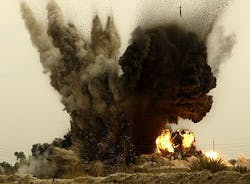Northrop Grumman to help develop RF seeker for future rocket-propelled bunker-busting bomb
EGLIN AIR FORCE BASE, Fla., 11 Sept. 2012.Munitions guidance experts at the Northrop Grumman Corp. Electronic Systems segment in Linthicum Heights Md., will help U.S. Air Force weapons scientists design precision guidance for a rocket-propelled bomb for the F-35 Lightning II stealth fighter-bomber that can attack and destroy enemy bunkers, tunnel complexes, and other important deeply buried targets.
The Air Force Air Armament Center at Eglin Air Force Base, Fla., awarded Northrop Grumman a $1.8 million contract last week to gather data necessary to support development of an RF seeker for the future High Velocity Penetrating Weapon (HVPW) program, which aims at developing a 2,000-pound bunker-busting munition with solid-rocket propulsion that will give the weapon the power of a 5,000-pound gravity bomb.
Air Force munitions experts are trying to develop an RF seeker for the future rocket-propelled HVPW bunker-busting bomb to enhance the weapon's accuracy -- particularly in areas where use of GPS receivers is difficult or impossible due to jamming and other countermeasures.
Northrop Grumman experts will gather data necessary to support development and analysis of a detailed RF seeker based concept for the HVPW. Air Force experts want to use RF seeker and guidance techniques for multilateration and offset tracking guidance.
Multilateration is a navigation technique based on measuring the difference in distance to two or more known locations that broadcast signals at known times to form a hyperbolic curve. To locate the exact location along that curve, a second measurement is taken to a different pair of stations to produce a second curve, which intersects with the first. Comparing the two curves produces only a few possible locations of a target.
Such sophisticated RF seeker technology is expected to help the HVPW hit featureless fixed targets, and fine tune the weapon's flight before and during boost, as well as provide off-bore-sight feature tracking and guidance estimates for closed-loop offset guidance.
In addition to Northrop Grumman, the Air Force has awarded HVPW FCC research contracts thus far to the Boeing Co. Defense, Space & Security segment in St. Louis; Lockheed Martin Corp. in Bethesda, Md.; MBDA Missile Systems in Paris; and Raytheon Co. in Waltham, Mass.
Raytheon's Space and Airborne Systems segment in El Segundo, Calif., won a contract last January to design and demonstrate navigation and guidance technologies to keep future generations of deep-penetrating bombs and missiles on target in conditions where GPS signals are degraded or unavailable. Boeing won a contract last month for HVPW concept development.
Next month the Air Force Research Laboratory Munitions Directorate (AFRL/RW), Hard and Deeply Buried Targets (HDBT) Capability Area (CA) integrated product team at Eglin Air Force Base will brief industry on the progress and future needs of the HVPW FCC program.
Briefings will cover future needs for bunker-busting munition guidance, navigation and control; propulsion; explosives; and systems integration, as well as the Global Strike Penetrating Munition for Conventional Prompt Global Strike (CPGS) and Functional Defeat program.
For more information contact Northrop Grumman Electronic Systems online at www.es.northropgrumman.com, or Eglin Air Force Base at www.eglin.af.mil.
Follow Military & Aerospace Electronics and Avionics Intelligence news updates on Twitter
